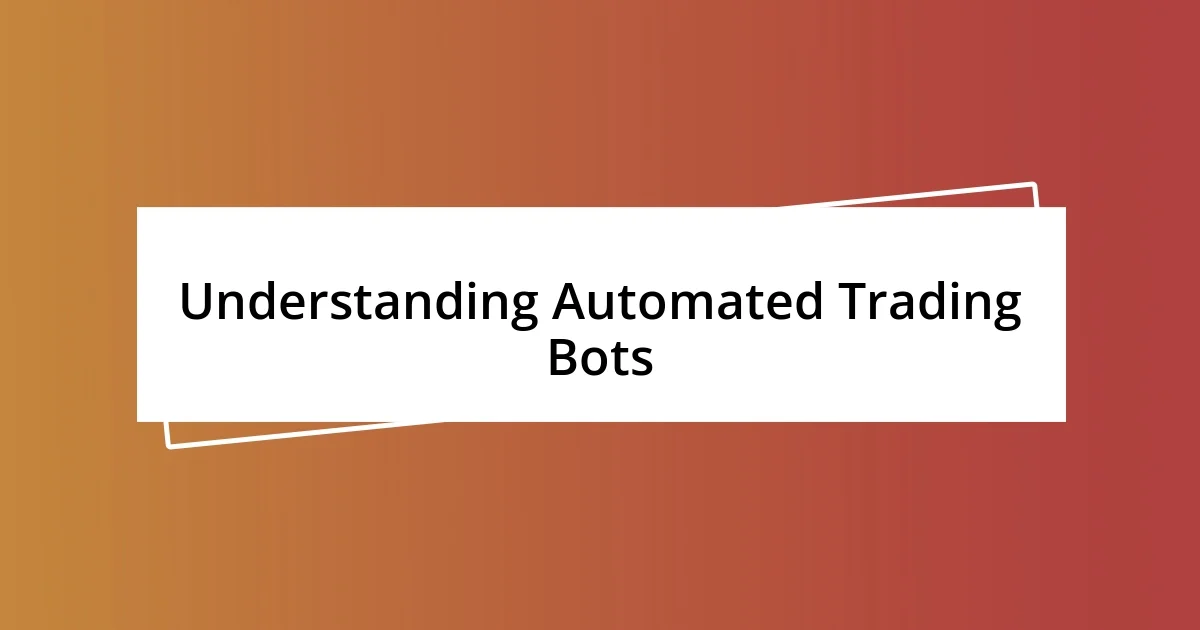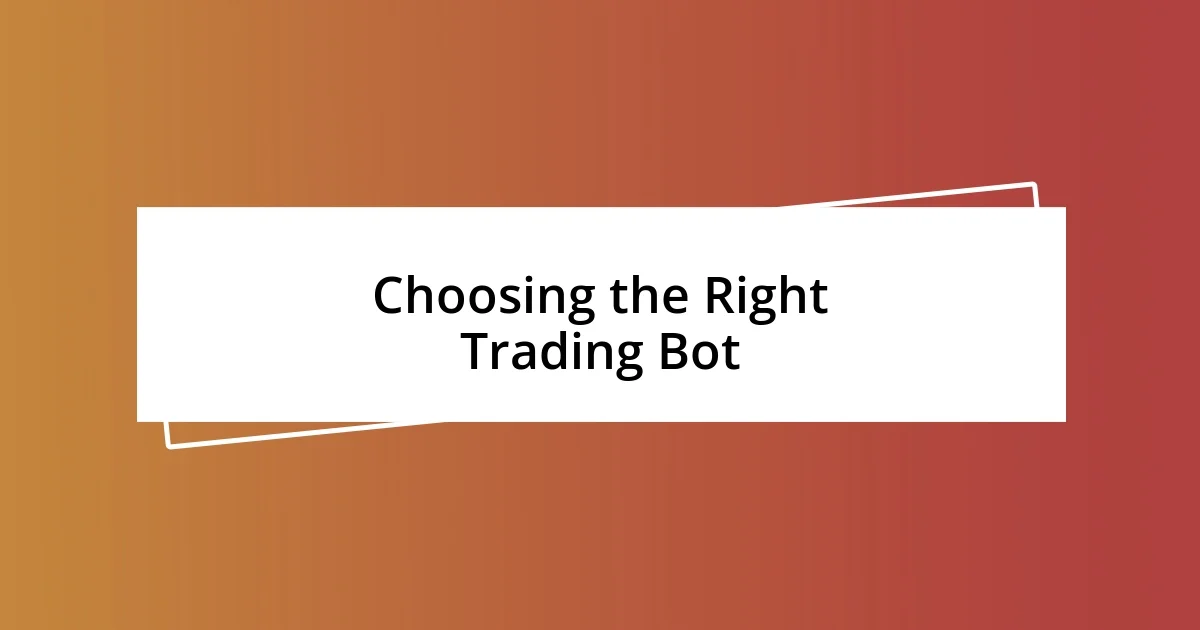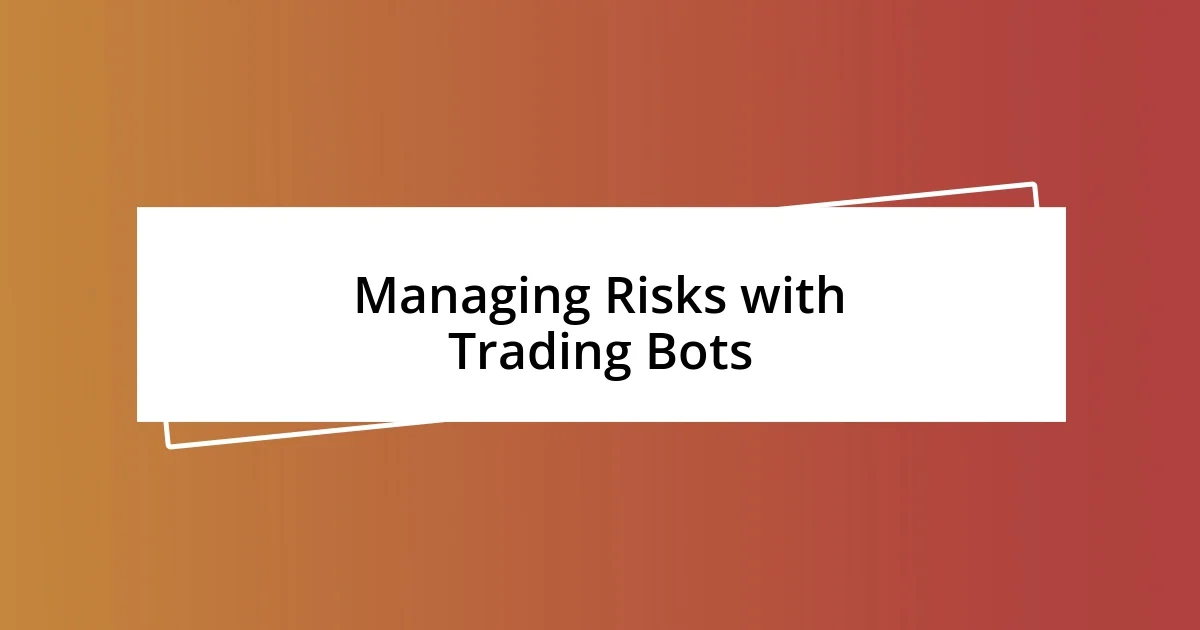Key takeaways:
- Watch for automated trading bots’ limitations; they require human oversight and adaptability during market volatility.
- Choosing the right trading bot involves evaluating performance history, user reviews, and customization options.
- Regularly monitor and adjust strategies while maintaining emotional discipline to enhance trading success over time.

Understanding Automated Trading Bots
Automated trading bots are sophisticated software programs designed to execute trades on behalf of traders. From my experience, they analyze market data and trends, making split-second decisions that humans simply can’t match. It’s fascinating to watch how these bots can operate with precision, often catching opportunities I might have missed in my own trading.
I remember the first time I set up a trading bot—it was both exhilarating and nerve-wracking. Would it perform better than I could? As I watched it work, I felt a mix of anxiety and excitement. Seeing profits roll in while I was free to focus on other activities was a game-changer for me. But it also made me wonder; could I fully trust a machine with my money?
It’s important to understand that while these bots can handle trades efficiently, they aren’t foolproof. I learned this the hard way during a volatile market. The bot I was using executed trades according to its programming, but in a sudden downturn, it couldn’t adapt as quickly as I could have. This experience taught me the importance of monitoring and adjusting my strategies even when relying on automated systems.

Choosing the Right Trading Bot
Choosing the right trading bot can be overwhelming given the myriad of options available. From my own experience, I found that not all bots are created equal; some are tailored for specific trading strategies while others offer broader functionality. I had to weigh factors such as ease of use, reliability, and backtesting capabilities. The right bot should not only align with my trading goals but also instill a sense of confidence that it can handle the unexpected.
Here are some key considerations to keep in mind when selecting a trading bot:
- Performance History: Look for bots with a proven track record and detailed performance metrics.
- User Reviews: Check platforms like forums and social media for credible user feedback.
- Customization Options: The ability to adjust settings based on your trading style is crucial.
- Customer Support: Ensure that the provider offers robust support services for troubleshooting.
- Cost Structure: Be clear about any fees or commissions involved to avoid surprises down the line.
In my case, I discovered that a bot I initially dismissed due to a modest fee had an incredible community of users exchanging tips that significantly improved my profits. In retrospect, the cost was trivial compared to the value I received, reinforcing the importance of not just looking at price tags but understanding what truly matters in performance and support.

Setting Up Your Trading Bot
When it comes to setting up your trading bot, the initial configuration can feel like a rite of passage. I remember my setup process was both thrilling and slightly daunting; I had to ensure everything was aligned with my trading strategy. One of the first steps I took was customizing the bot’s parameters based on my risk tolerance and investment goals. Watching it take shape felt empowering, almost like I was designing a little financial assistant tailored just for me.
I can’t stress enough how crucial it is to thoroughly test your bot in a simulated environment before going live. The first time I hit the “start” button on my bot, my heart raced with anticipation. I diligently monitored its performance over the first few weeks to catch any bugs or adjustments it might need. It was enlightening to see that even small tweaks in parameters could significantly change outcomes—almost like fine-tuning a musical instrument for the best performance.
Throughout this process, I developed an appreciation for user-friendly interfaces in bot software. I once struggled with a particularly complex bot that overwhelmed me with options. After a frustrating few days, I switched to a more intuitive platform that allowed me to focus on strategy instead of getting tangled in technicalities. The ease of setup and operation made all the difference in my trading experience, proving that technology should be an aid, not a hurdle.
| Aspect | Consideration |
|---|---|
| Customization | Set parameters based on risk and goals |
| Testing | Simulate performance before live trading |
| Interface | Choose user-friendly software |

Strategies for Effective Trading
When I first delved into trading strategies, I found that diversification was my best ally. It felt freeing to spread my investments across different assets instead of putting all my eggs in one basket. I still remember the rush of seeing my bot automatically adjust its trades to capture opportunities in various markets—it was like having a safety net that allowed me to sleep at night without worrying about a single market crash.
Another strategy that worked wonders for me was setting realistic profit targets. Initially, I aimed too high and faced disappointment when my bot didn’t perform as expected. Through reflection, I adjusted my targets to more achievable levels, which not only boosted my confidence but also motivated my bot’s performance. Finding that sweet spot between ambition and realism turned my trading into a sustainable journey rather than a stressful sprint.
Finally, I can’t overemphasize the importance of regular review and adjustment of your strategies. Think of it like tending to a garden; you need to nurture and prune to see growth. There were moments when I felt like my bot was stalling, but once I took the time to analyze the data, fine-tune my strategies, and stay adaptable, everything began to click. Have you ever revisited your goals only to find that a small change could lead to significant improvements? That sense of progress is incredibly satisfying and keeps me motivated to explore new trading horizons.

Monitoring Trading Bot Performance
Monitoring the performance of my trading bot was a real eye-opener for me. In the beginning, I was glued to my screen daily, analyzing every trade it made. I quickly learned that while initial excitement can cloud judgment, consistent monitoring is crucial. How often have you found yourself second-guessing a decision based on a fleeting performance dip? It’s easy to overlook long-term gains when focused too much on day-to-day fluctuations.
I remember the first time my trading bot hit a rough patch—it felt like a punch to the gut. My instinct was to panic and pull the plug, but instead, I took a deep breath and dove into the performance metrics. By examining the data, I could separate noise from real signals. It was thrilling to uncover patterns that indicated my bot might just be adjusting to market volatility. Have you ever sat down with numbers and turned panic into strategy? That transformation is so empowering.
Over time, I developed a routine for my bot’s performance reviews, and I found it remarkably beneficial. I set aside a specific time each week to reflect on the trades executed. This practice not only helped me identify what worked and what didn’t but also gave me insights into refining my trading strategies over time. Each review session felt like a mini-celebration of learning and growth. Isn’t it fascinating how these reflections can lead to more profound understanding and confidence in your approach? Those moments became key to nurturing my long-term success in trading.

Managing Risks with Trading Bots
When managing risks with trading bots, one of the most effective measures I found was to set strict stop-loss orders. I’ll never forget the first time I ignored this advice. Watching my investment drop sharply without any pre-set exit points felt like a rollercoaster without a safety bar. It was a gripping reminder of how crucial it is to have a fall-back plan. Isn’t it better to make calculated decisions rather than be at the mercy of market whims?
I also believe in a thorough backtesting process before deploying my bot in live markets. When I first did this, I was amazed at how different the results looked compared to my initial expectations. Running simulations helped me recognize potential pitfalls before they became real losses. It’s almost like running a movie in slow motion; you catch the details you might have missed otherwise. Have you ever run a simulation and realized you were headed for trouble? That realization is priceless, akin to getting a peek at a hidden chapter of your trading narrative.
Lastly, I’ve learned the value of emotional discipline in trading, especially when you rely on algorithms. There were days I felt my nerves fraying, watching the markets shift rapidly. Instead of letting emotions dictate my choices, I began to trust the logic and consistency of my bot. Keeping a trading journal helped me track my feelings and reactions to market changes, leading to better decision-making. Isn’t it fascinating how self-awareness can improve both performance and mental resilience? Embracing this discipline has transformed my trading journey into a more balanced and enjoyable experience.

Final Thoughts on Trading Bots
Reflecting on my journey with trading bots, I’ve come to appreciate their potential to enhance my trading strategy. I recall a particular night when I was sleep-deprived from monitoring market shifts. Just as I was about to throw in the towel, my bot made two successful trades back-to-back, serving as a reminder of why I invested time in automation. Can you relate to those moments when technology outshines our human limits? It really drove home the lesson that trading bots can operate tirelessly while I focus on refining my strategy.
I’ve also learned that while bots can streamline trading, they’re not a silver bullet. I remember when a sudden market event caught my bot off guard, resulting in unexpected losses. That experience taught me the vital importance of adaptability and setting realistic expectations. After all, isn’t the real goal to complement our strengths rather than rely solely on automated systems? It’s crucial to remember that these tools require supervision, and success often lies in striking the right balance between automation and personal insight.
Ultimately, using trading bots has transformed my approach, but it has also reinforced the need for an active role in my investments. I’ve found that combining the efficiency of bots with my human instincts creates a powerful synergy. Have you ever wondered how your intuition can play a critical role alongside technology? It’s about leveraging automation while remaining engaged in the process. This dynamic balance is what has truly shaped my trading experience, allowing me to navigate the ups and downs of the market with both confidence and curiosity.














